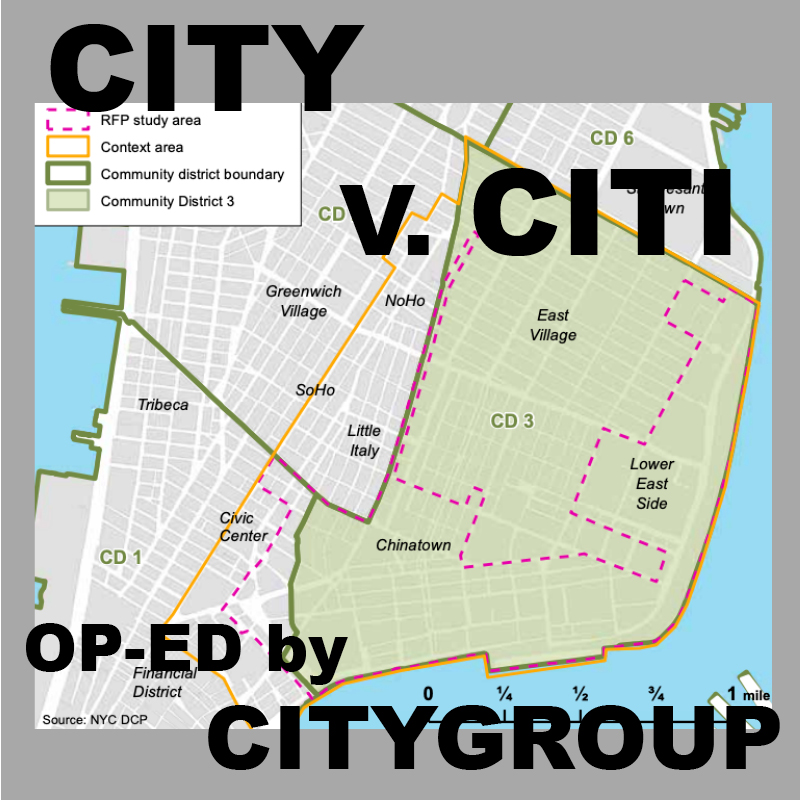
On June 5, 2019, we will stand with the plaintiffs of the Two Bridges lawsuit at 60 Centre Street to support their case against the approval of the four proposed luxury megatowers. Many people and groups have come together in holding Mayor de Blasio and his administration accountable for their failure to protect our communities for working people and their refusal to support community-led rezoning. While we await the court’s decision, we thought it was a perfect time for a Chinatown Working Group Rezoning Plan post.
The following post was written by Citygroup*, an architecture collective in a storefront in the Lower East Side that seeks to develop a strategy for defining the city as a place for all to live in dignity. Through debate, regular meetings, exhibitions, and projects, they interrogate the conditions that exploit architects and trivialize architecture.
_____________________
At a recent meeting of the Chinatown Working Group, the following discussion occurred: one of the group’s longtime members expressed confusion about use of the word “City.” This individual did not understand why people often use the word to reference the central government and decisions made by the Office of the Mayor. For example, it is not unusual for someone to say something like “the City decided to decrease funding for affordable housing.” For the aforementioned Chinatown resident, this statement is problematic because use of the word “city” should refer to the people in the city and not the administrative authority that oversees the city. The group then continued this discussion and asserted that the way in which the word city is linguistically deployed is an important indicator of who controls future development of the city. They suggested that the further the word city is estranged from a notion of who inhabits the city, the more the city becomes a place defined by a privileged minority. Although this was not discussed at the working group meeting, the widespread appearance of the word “citi” throughout the five boroughs also signals corporate control of public space. In the end, the Chinatown Working Group pledged to carefully consider how they deploy language, especially in reference to the word city.
Preserving the meaning of this word is fundamentally why the 2013 Chinatown Working Group Plan is essential. Beyond the realm of language, the plan proposes policy and zoning code that will prevent unbridled development in Chinatown and the Lower East Side and ensures that the city is a place for all to live in dignity. The plan was the result of years of consensus-building in three languages among over thirty community organizations who came together as the Chinatown Working Group (CWG) in order to develop strategies for countering increasing resident displacement due to rising rents, land use changes, redevelopment, and tenant harassment. The plan puts forward a number of policy proposals across several subdistricts; these proposals include the creation of historic districts, height limits, maintaining public ownership of NYCHA redevelopment sites, as well as rezoning for increased density. The de Blasio administration rejected the plan in 2016 and Chinatown remains without a rezoning plan, unlike the neighboring East Village. Despite official denial of the plan, there remains strong neighborhood support for the plan.
In conjunction with organizing against the proposed Two Bridges towers, continued advocacy of the Chinatown Working Group Plan is an essential aspect of protecting the character and culture of Chinatown and the Lower East Side. While standing against the towers is a vital act of opposition, organizing behind the zoning plan is forward-looking and allows the community to present their vision of the neighborhood. Alongside defeat of the tower proposals, residents can present the zoning plan as their alternate proposition for the simultaneous preservation and development of the area. Undeniably, top-down zoning serves unbridled profit-driven spatial and market growth that only benefits real estate developers and affluent communities. Further, acceleration of racial and wealth segregation across New York City is a consequence of conventional zoning strategies led by city planners and government officials. When city officials are required to seek community feedback, typically as part of the Uniform Land Use Review Procedure (ULURP), citizen input results in minor palliative alterations to zoning plans that inevitably foster dramatic changes to a neighborhood. The unfulfilled promise of participation is why communities often reject the ULURP process and refuse to succumb to a system that does not recognize their needs and rights. In contrast, the the Chinatown Working Group Plan is a bottom-up statement that originates from within the neighborhood. In detail, it proposes a vision for Chinatown as a place for all people to thrive and where land is held and used as a common good. Ultimately passing the entire plan in full is necessary to maintain the city as the city and not the citi.
*citygroup is an architecture collective based in downtown Manhattan. We formed to challenge the structural and cultural forces that shape the normative practices of architecture. We recognize that architecture tends to be beholden to conservative authority, both economic and political, as evidenced in particular by the architectural profession’s profound inability to address the global housing crisis and protect the city from unbridled profit-driven development. We are unwilling to defer to the status quo of capitalist political economy and believe we must interrogate the conditions that subjugate, alienate, and appropriate architects, architecture, and inhabitants of architecture. We challenge one-directional and hierarchical communication and advocate for a discursive model of knowledge, which we believe in turn engenders solidarity. Participation defines membership in citygroup, as we seek to valorize use, encounter, and the authorship of the collective over that of the individual. Our aim is to establish an enclave for the production of theory and strategy that supports an alternative approach to architecture and a life of dignity for everyone in the city.
Leave a Reply